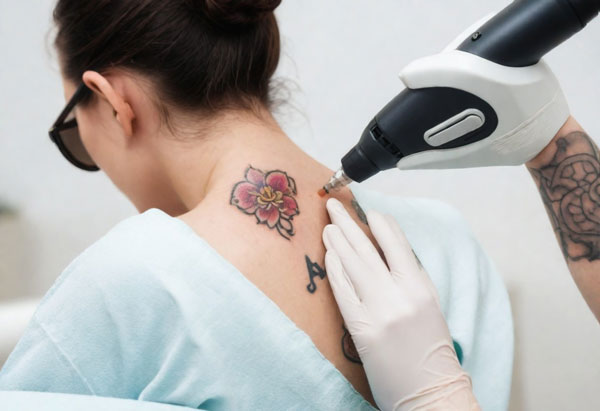Curious about how laser tattoo removal works? Say goodbye to unwanted ink with this advanced procedure. Unlike the pain of getting a tattoo, removal is surprisingly quick and relatively painless.
Using high-intensity light beams, lasers break down the tattoo’s pigment into tiny particles that are naturally eliminated by the body. This process effectively fades tattoos without harming surrounding skin. Ready to erase that ink? Discover the science behind laser tattoo removal and bid farewell to your old designs for good.
Understanding Tattoo Removal
Types of Removal
Tattoo removal methods vary, including dermabrasion, salabrasion, and surgical excision. These methods involve physically removing layers of skin or the tattoo itself. While they can be effective, they are often more painful and may lead to scarring.
In contrast, laser removal is the most popular due to its precision and reduced risk of scarring. Laser removal works by breaking down the ink particles in the skin without causing significant damage.
Laser Removal Basics
Laser tattoo removal employs high-intensity light beams to target and shatter the ink particles embedded in the skin. The process involves using different wavelengths of light to match specific ink colors.
As the ink particles break down into smaller fragments, the body’s immune system naturally eliminates them over time. Multiple sessions are necessary for complete removal as each session targets different layers of ink.
Effectiveness and Limits
Laser tattoo removal is highly effective for fading or removing tattoos, especially those with black ink. However, colored tattoos may require more sessions for complete removal. Despite its effectiveness, laser removal has limitations.
Some tattoos may not respond well due to factors like ink depth, color composition, or skin type. Complete removal is challenging for certain tattoos, leading to potential remnants or alterations in the skin’s texture.
3 Laser Tattoo Removal Process
How Lasers Break Ink
Laser tattoo removal works by emitting high-intensity light pulses that penetrate the skin. These pulses break down tattoo pigment into smaller particles, making it easier for the body to eliminate them naturally. The heat generated by the laser plays a crucial role in this process, aiding in fragmenting the ink.
Skin Interaction
During laser tattoo removal, the skin responds by absorbing the light energy, causing the tattoo pigment to shatter. Different skin types react uniquely to this process, with factors such as skin tone influencing treatment effectiveness. Potential side effects like redness, blistering, or temporary discoloration may occur but are typically mild and transient.
Session Duration
A typical laser tattoo removal session lasts around 15-30 minutes depending on the tattoo’s size and complexity. Factors like ink colors, depth, and age of the tattoo can influence session duration. Consistency is key for optimal results; attending all scheduled sessions is crucial for successful removal.
The Necessity of Multiple Sessions
Ink Particle Breakdown
Laser tattoo removal involves breaking down ink particles using high-intensity light beams in picoseconds. The laser energy targets the pigments, causing them to fragment into smaller particles.
These fragmented particles are then eliminated by the body’s immune system over time. As the body processes and removes these particles, the tattoo gradually lightens after each session.
Color and Depth Factors
The color and depth of a tattoo play crucial roles in the removal process. Darker colors like black absorb more laser energy, making them easier to remove compared to lighter shades. Colors like green and blue can be more challenging due to their composition.
Tattoos with deeper ink penetration require more sessions as the laser must reach deeper layers of skin to break down the pigments effectively.
Healing Between Sessions
Allowing sufficient time for the skin to heal between sessions is essential for effective tattoo removal. During this period, the body naturally flushes out fragmented ink particles through lymphatic drainage.
Proper aftercare practices such as keeping the treated area clean, avoiding sun exposure, and moisturizing help promote faster healing and minimize potential side effects.
Alternatives and DIY Methods
Professional vs. Home Removal
Professional removal offers expertise and advanced equipment, ensuring efficient and safe tattoo elimination procedures.
At home, the risks of DIY methods include incomplete removal and potential skin damage from improper techniques. Attempting DIY removal at home lacks the precision and safety measures provided by professional tattoo removal services.
Risks of DIY Methods
DIY methods pose risks such as scarring, skin infections, and pigment changes due to inadequate knowledge and tools. Complications like allergic reactions or severe pain can arise from using homemade removal solutions without proper guidance. Seeking professional help is crucial to avoid adverse effects and ensure a successful and safe tattoo removal process.
Final Remarks
Now that you understand the ins and outs of laser tattoo removal, you can make informed decisions about removing your unwanted tattoos. Remember, multiple sessions are necessary for complete elimination, so be patient throughout the process.
Consider consulting a specialist to ensure the best results and follow the recommended aftercare routine diligently for optimal skin healing. Stay committed to the timeline outlined for your tattoo removal journey, and explore alternatives if needed. Your dedication will pay off in achieving the clear skin you desire.
Take charge of your tattoo removal journey today by applying these insights and recommendations. Your commitment and informed choices will lead you to successful tattoo elimination. Good luck on your path to a tattoo-free future!


